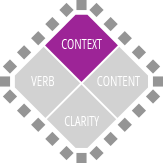Teaching & Learning
How to write ILOs
5 Steps to writing ILOs
It can be useful to consider using the following 5-step process in designing ILOs:
- Decide on the Purpose
- Identify the Content
- Select the Appropriate Verb
- Add the Context (when necessary)
- Ensure Clarity
Below is more information about each of these steps, with reference to the examples on the Components of an ILO page.
Step 4: Context

When you have identified what the students will learn, and what they will do with it, the next step is to define the context in which students will be able to do the verb with the content.
When selecting the appropriate context, it is important to consider the place the unit occupies within the course structure, and its contribution to student development towards CLOs, just as when selecting
verbs. It may be one or the other of these two elements of an ILO that defines and communicates the complexity of the knowledge, skill or understanding required by students at this point of the course. Mapping to CLOs will assist in identifying the most suitable context, as will discussing with colleagues
the contexts of the ILOs in other units offered at a similar point in the course.
Context helps to define and put limits around what you are going to teach the students within the unit. The identification of a context is most important at Bloom's revised level of apply and above.
If the level of performance or understanding is sufficiently identified by the verb and content, and the context is inherent, then there may be no need to directly specify a context. Additionally, when there is an expectation of deployment free of context or in multiple contexts, then particular context
need not be specified in the learning outcomes. This is of particular relevance for foundational and theoretical concepts, which students may be expected to be able to apply in multiple contexts.
Examples
The first example provided, for instance, is an example of an ILO where the verb and the content provide sufficient information for students to understand the expectation of them without inclusion of a context.
ILO Example 1, context:
Explain the concept of objects in linear and rotational motion and the relationships between motion, force and energy with reference to Newton's three laws of motion.
For our second example, however, further clarity is needed to identify for students how, where, when, and in what circumstances or situations they will be expected to deploy the chosen verb. Depending on the verb that is chosen, appropriate contextual information might include:
ILO Example 2, context:
identification of abnormalities or clinical scenarios
The third example requires a very specific personal context:
ILO Example 3, context:
your own practice(s)
